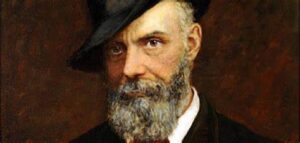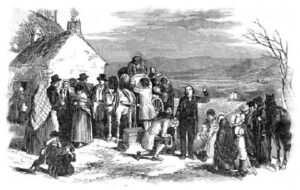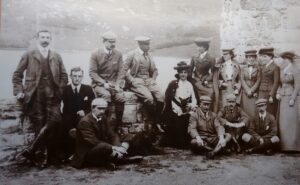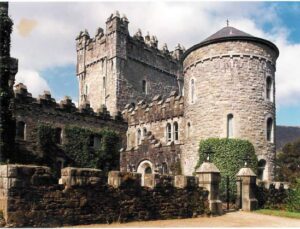The life and death of Black Jack Adair, the mastermind of the Derryveagh Evictions

By John Joe McGinley
It is often said that everyone is well thought off when they die, but there is one man with links to Gweedore in North West Donegal, of whom that can never be said. He was the Landlord ‘Black’ Jack Adair, the mastermind of the infamous Derryveagh Evictions.
Early life
John George Adair was born on the 3rd of March 1823 to landed gentry in modern day County Laois, which was then known as Queens County. The Adairs were a wealthy family, loyal to the crown and with a long tradition of serving the British in Ireland and abroad.
John George Adair was born on the 3rd of March 1823 to landed gentry in Queens County
They had been landlords in Ireland since the 17th century when John’s ancestor Colonel Robert Adair had been rewarded by King William of Orange for his service at the Battle of the Boyne. Robert Adair raised and led a regiment at the Boyne and was given a knighthood and large tracts of land in Queens County. The Adairs also had a cousin who was a Baronet and a member of parliament.
Young John George Adair’s family had land and money, his father had inherited sugar plantations in the West Indies, which funded a comfortable lifestyle.
The infant Adair known to his family and friends as Jack, had his career mapped out for him by his parents, who decided he too would serve the crown. So, after attending Trinity College in Dublin, Adair entered the British diplomatic service.
Those that knew Jack Adair thought this was a strange career choice, given his short temper and aloof personality. Many that met the young Adair, often commented that he did not hide his confidence or sense of self-importance. Whilst this was not uncommon in the scions of the Anglo Irish landed gentry, it was hardly the smooth temperament required for international diplomacy.
Despite these reservations, Adair was posted to Florence. It was here he would develop a love for Italian architecture and garden design that would have a major influence over him in later life.
A young Adair enjoyed the social life that the cosmopolitan city of Florence offered a carefree diplomat. He was soon mentored by a British financier living in the city called John Leland Maquay. It was rumoured, that Adair repaid Maquay’s kindness by having an affair with his wife and even fathering a child with her. (1)
It is unclear whether Maquay knew or even approved of this liaison, but the child William was raised by John Maquay as his own son.
Despite enjoying the delights of Florence, Adair’s fiery temper did not make international diplomacy an enjoyable career and he decided to leave the diplomatic service and try his hand at finance. Encouraged by Maquay, Adair made for America in the 1850s settling in New York.
After making a fortune in finance in New York, Adair bought up large tracts of land in Derryveagh, Donegal.
He founded a brokerage firm and soon made a fortune speculating in mortgage loans and real estate. Adair would later expand his business with an office in Denver Colorado. He choose this location because of his interest in buffalo hunting and the opportunities offered by the ever-expanding American west.
Now a wealthy young man, he returned to Ireland to set up another business venture. He decided to invest some of his profits in Donegal, where he began to buy up smaller holdings of land around the Derryveagh Mountains and Gartan to create a single large estate of 28,000 acres (110 km2).
This was named Glenveagh, after the local name for the general area, which translates as “glen of the birches”. It was here, in 1861, that he would carve his name into infamy with what became known as the Derryveagh evictions.
The Derryveagh Evictions

Adair’s relationship with his tenants did not start well, in 1860 he began hunting on land he had rented to tenants, in violation of the rental agreements.
When the tenants quite rightly objected, an arrogant and angry Adair threatened them with eviction.
Adair had a vision for Glenveagh, and this was based on his admiration for the Balmoral estate of Queen Victoria and the gardens he had seen in Florence. He wished to build a palatial castle, ornamental gardens, introduce deer hunting and establish a working estate based on deer and sheep and not the needs of the native Irish tenant farmers.
Adair began to import sheep and employed two shepherds, Rankin and Murray from Scotland.
Adair attempted through an agent to clear the land at Derryveagh for sheep farming, his agent was eventually murdered.
Understandably, neither shepherd was popular with the local tenants, who had seen their land turned over to sheep farming. It was no surprise that dead sheep began to appear throughout the estate.
Murray was particularly disliked and was constantly bickering with the locals and had several drunken fights with them in local drinking dens. In November 1860, Murray was reported missing by his pregnant wife. It was not long until his lifeless, beaten and broken body was found in a remote ditch.
It was clear that he had been murdered and local farmers were suspected. Rumours quickly began to spread that Murray had been murdered by his fellow shepherd Rankin. Locals alleged that Rankin was having an affair with Murray’s wife and that he moved into her bed on Murray’s death. This was to prove unfounded as she was heavily pregnant at the time of Murray’s disappearance and soon left for Scotland once her child was born, without Rankin.
Another rumour, again unfounded, was that Adair had ordered Rankin to kill Murray, to allow him to blame the locals. (2) Rankin was presumed innocent and was placed under police protection.
No matter the truth of the rumours, two things were soon clear. First, the local Constabulary had no idea who had murdered Murray the shepherd and secondly, relations with landlord and tenants were now at a low point.
Sources are available that claim Adair, who was a Justice of the Peace at the time of the murder, was unhelpful to the Constabulary, who complained of the poor support they received from Adair. One is quoted as saying in a letter:
“I spoke to Mr Adair on the 20th of November to provide us with fuel and light, which he declined to give us. He also refused to allow us to cut timber. We have to patrol the mountains during the day and return at night to a damp cold house, with our clothing wet, ourselves fatigued from cold and want of food, having no fire to cook our victuals or dry our clothing.” (3)
Despite the investigation, no one was ever found guilty of the murder and the unrest between landlord and his tenants continued to ferment, while Adair secretly began the plans to finally implement his grand vision for his Glenveagh estate.
On St Patrick’s Day (17th March) 1861 Adair obtained a writ of Habere facias possessionem. This document granted him the legal, if not the moral right to evict his tenants and take back possession of his land.
In 1861, Adair, a Justice of the Peace, assembled a large fore of police and private ‘crowbar men’ to evict 44 families in the area and to demolish their homes.
He now began to gather a group of policemen and thugs termed as ‘Crowbar men’, with experience in evictions. The role of the ‘crow bar men’, was to demolish the dwelling place once the inhabitants had been evicted. This ensured no one could return to the property.
On 8th April 1861, a force of 200 police, three sub officers, the resident magistrate, and the sub-sheriff of Donegal Samuel Crookshank left from Letterkenny to undertake their legal duties. They met with the ‘Crowbar men’ at Glenveagh.
The evictions began at Lough Barra, where a widow, Mrs Hanna McAward and her six daughters and one son were the first to suffer. The family were evicted from the house, and with them removed, the crowbar men made short work of demolishing it.
The Newspaper reports of the time detailed a harrowing scene in which ‘the recently bereaved widow’ and her family were frantic with despair.
“Throwing themselves on the ground, they became almost insensible, and bursting out in the old Irish wail”. (4)
The frightening convoy then went from house to house over the next 3 days through Magerashangan, Staghall, Claggan, Ardator and Castletown among other townlands. Twenty eight houses were levelled to the ground by the ‘crowbar men’.
When the evictions were over, 44 families were impacted making a total of 244 people left homeless including 159 children. All too clear 11,600 acres of mountain and valley land. In the aftermath of what would be called the Derryveagh evictions, 42 of those evicted ended up in the workhouse, the terrible last resort of the desperate and destitute.
The press coverage of the suffering of those evicted ensured that their story was heard by Irishmen and women across the world. Money was raised to help them in Dublin and France. The Australian Donegal Relief Committee was established to assist the emigration of the Glenveagh people to Australia.
This was a charity organised in Sydney by a Donegal migrant named Michael O’Grady. He arranged for fares to be paid for anyone wishing to emigrate and for land to be purchased for them in Australia.
Over half of those evicted would eventually decide to immigrate to Australia. On 18th January 1862, the Glenveagh families left Donegal to begin their journey. One hundred and fifty sponsored passengers from Derryveagh boarded the Abyssinia to Sydney in April 1862. The journey took 114 days.
Once settled in Australia they established successful new lives for themselves and their descendants who continue to thrive in Australia. The story of the evictions has been passed down the generations and they remember their ancestors who suffered one of the most infamous evictions in Irish history.
The Marriage of Jack and Cornelia

The story of Black Jack Adair does not end with the Derryveagh evictions or even in Donegal. His story has more twists and turns and continued across the Atlantic.
With the vision for his estate being implemented, Adair left Donegal to return to America to ensure his brokerage business was being run effectively.
A confirmed bachelor in his 40s it was a surprise too many, that at a ball in New York City he met Cornelia Wadsworth Ritchie, and began to romance the 32 year old widow, who would become his future wife.
Adair then returned to America where he married Cornelia Wadsworth in 1867.
Cornelia Wadsworth was born in Philadelphia on April 6th, 1837, but grew up at Hartford House, the family estate near Geneseo, New York. In 1857 Cornelia married Montgomery Ritchie, the grandson of Harrison Gray Otis, the third mayor of Boston.
They would go on to have two sons before Montgomery joined her father, Major Gen. James S. Wadsworth, to fight for the Union in the Civil War. Major General Wadsworth served with distinction at Gettysburg, but died in a Confederate field hospital on May 8, 1864, two days after falling wounded at the Battle of the Wilderness.
Montgomery Ritchie retrieved the general’s body and brought it home to Geneseo, then returned to the front lines. Sadly, just weeks later Ritchie himself died of fever.Cornelia was now a widow, left without a father or husband and 2 young children to bring up.
Two years later she attended a Republican Party reception and met the 46-year-old Adair. It was undoubtedly a love match and the pair were married a year later in 1867.
They honeymooned at Glenveagh, where John shared his vision of the estate. Cornelia fell in love with the area and the plans for the estate and work would soon begin on Glenveagh castle.
They spent their time between Ireland, England, and New York. Cornelia also became a naturalized British citizen. Jack Adair disliked New York and when his brokerage firm began to fail in 1874, he encouraged Cornelia to join him when he looked west for new investment opportunities.
The JA Ranch
The couple and the two sons headed west to Denver, where Adair would temporarily move his brokerage business to his Denver office.
In April 1874 on a guided buffalo hunt, In eastern Colorado, near Pueblo, they met Texas cattleman Charles Goodnight.
The Adairs moved their brokerage business to Denver Colorado in the 1870s, where John Adair loved to hunt buffalo.
Goodnight was an Illinois native and former Confederate Colonel. Despite Cornelia having lost both a father and husband in the Civil War, Adair and his wife soon became firm friends with the gregarious Goodnight, who ten years previously had been involved in the famous “gather” of feral cattle that had been living wild across Texas during the Civil War.
Goodnight was already a famous name in the west having driven cattle herds north to Colorado along what became known as the Goodnight-Loving trail (Oliver Loving being the other leader of the drive). (5)
He had then formed a partnership with cattle baron John Chisum, taking his herds to Colorado to sell to the army. The railway was expanding, however, and Goodnight could clearly see that the days of the great cattle drives were coming to an end.
During the hunt Goodnight regaled the couple with stories of the Palo Duro Country southeast of Amarillo, Texas. He described land which was ideal for grazing cattle on the open range. The cattle had ample grass in summer and could over winter in mild conditions protected by canyon walls. The land also had flowing rivers as well as outstanding natural beauty.
Goodnight was not just passing time with his wealthy clients on the Buffalo hunt, he was trying to attract a partner to help him establish a cattle ranch in Palo Duro.
Adair and his wife were intrigued and looking for investment opportunities, but they were not so stupid as to buy land they had not seen. They decided that they would travel with Goodnight and his wife to see the proposed ranch for themselves.
In May 1877, Charles and Mary Goodnight, the Adair’s and four cowboys, 100 Durham bulls and four wagonloads of provisions set off for the Texas panhandle.
The journey took twelve days, and was not without adventure. Local outlaws had heard of the wealthy investors from the east and decided to kidnap the Adair’s. They even went so far as to have a hideout established to hold them prisoner. Goodnight who was a man with many friends heard rumours of the plot and arranged for an escort for the party from the US cavalry. The kidnappers decided to end their scheme and the danger was averted.
Adair’s legendary ill temper hampered the trip as he fell out with the cowboys who resented his high handed treatment of them. Again Goodnight came to the rescue intervening to ensure the cowboys did not beat up his potential partner. Goodnight would later reflect that sometimes he regretted not fighting Adair himself! (6)
In contrast, while Adair was making enemies Cornelia was making friends and enjoying the spectacular beauty of the west. When the Adair’s came to the Palo Duro, they realised Goodnight was not exaggerating and they immediately realised the potential the land offered and decided to establish a cattle ranch.
It was Cornelia Adair who picked out the site for the ranch house and so it is her rather than Jack who can be regarded as the true founder of the ranch.
Goodnight and Jack now talked about how the ranch would be established and financed. Adair saw the enormous potential and was keen to invest. Adair proposed that he would provide two thirds of the capital and Goodnight the remainder. Adair offered Goodnight a shrewd deal.
He would borrow his one-third share at 10 percent interest from Adair. Goodnight would be the daily manager of the ranch and supply the starting cattle. He would also draw an annual salary of $2,500. (7)
It was Goodnight’s suggestion that the ranch be named the “JA” for the initials of his financial partner, Jack Adair. Goodnight began buying up additional land around Palo Duro Canyon, making sure the tracts were good for grazing and had enough water.
The following year Goodnight drove the first JA herd north to the railhead at Dodge City, Kansas. By 1882 the ranch had grown to 93,000 acres and had realized a profit of $512,000. In its peak year in 1883, the ranch encompassed 1,335,000 acres (5,400 square kilometres) in portions of six Texas counties and boasted 100,000 head of cattle. (8)
Jack only visited the ranch 3 times in his life, his real love was his estate in Donegal and he began to use the profits he had made in Texas to make his dream of a rival to Balmoral in the hills of Donegal a reality.
Glenveagh Castle

The tragedy of the Glenveagh evictions had shocked Ireland but had allowed Jack Adair to begin the creation of his vision of an estate to rival Balmoral in Scotland.
Work began on the castle in 1867 initially by Jack but then in partnership with his new American wife Cornelia. The castle the couple wanted was designed by Adair’s first cousin John Townsend Trench, a land agent with a flair for design but with no architectural training.
Despite this he also designed a concrete Gothic town hall and other improvements on the Earl of Carysfort’s estate at Arklow, County Wicklow.
Glenveagh Castle in Donegal was built to resemble a medieval fortress, but the interior was plush and modern.
Jack Adair’s plans for his estate did not lack ambition and Glenveagh castle was built imitating the style of earlier Irish Tower-houses adding an air of antiquity to the castle. The building stone chosen was granite, plentiful in Donegal but difficult to work and allowing for little detail.
His time in Florence as a diplomat influenced the design of the gardens which were planted in both the Italian and French style, all with views of the glen. The interior of the castle matched the grandeur of the exterior, he decorated it with sculptures both new and old, including sphinxes, figures of Greek Gods, busts in the Tunisian style and even two temple guardians taken from distant Bali.
The castle itself boasted a grandiose exterior, but a thoroughly modern interior.
With his dream home now built and with money to spend from the profit from his Texas ranch, Jack now turned to transforming the land around Glenveagh into the hunting and sheep estate he desired.
However, Jack Adair would not have the time to see his plans come to fruition. “Black Jack” as the locals called the hated landlord remained a loathed figure in Donegal. In 1884 the Edinburgh naturalist James Sconce reported that a woman from a family he had visited in Gartan had been overheard bargaining with a man to take her out to Tory Island where there was:
“… a stone which, if it could be turned, and the name of Mr Adair repeated over it, would have been sure to bring about his death within a year”. (9)
This was the famed cursing stone of Tory Island, which according to folklore could bring death and destruction for anyone unlucky enough to face its wrath.
The woman was said to have died before she could make the trip, but perhaps someone made it in her honour. For the following year in 1885, while on one of his frequent trips to America, Jack Adair died.
After his last trip to the Palo Duro JA ranch, accompanied by his valet, Adair began the return trip to Ireland. He died of natural causes, age 62, while in St. Louis, Missouri.
The death of Jack Adair
Despite the rumours of fathering a child while on diplomatic service in Florence, Adair had no heirs other than Cornelia who inherited his entire estate including Glenveagh and the JA ranch.
Adair was buried in The Lea Church (Church of Ireland), Killenard, County Laois, Ireland, near Belgrove house, Belgrove, Ballybrittas, another one of his other residences, near where he was born. The night before he was buried, a dead dog was thrown into his open grave. It was speculated this was done by disgruntled tenants.
In Glenveagh, his wife Cornelia had the face of a large rock inscribed with his name and the inscription “Brave, Just and Generous”. This did not last long!
‘Black Jack’ Adair died in America but was buried in Ireland. A dead dog as thrown in his grave – proof of the continued resentment his evictions of 1861 had provoked.
There is a legend that lightning during a thunderstorm broke the rock into many pieces which fell into the nearby lake. I personally think human rather than divine intervention was responsible.
Two years after his death, Adair’s property Belgrove House, which was an exceptionally large, country mansion was destroyed in a fire. To this day its ruined remains are called the ‘burnt house’. Cornelia would never remarry and spent the rest of her life living between England, Ireland, and America.
In America Cornelia inherited Jacks two thirds share in the JA ranch. She worked well with Charles Goodnight who continued as manager until 1888, when he decided to strike out on his own. Goodnight acquired the 140,000-acre (570 km2) Quitaque Ranch with 20,000 head of cattle. (10)
From 1888 until her death, she was the sole owner of the ranch. Her son Jack had worked on the ranch in his early adulthood but ran afoul of Goodnight’s strict work ethic. Goodnight demoted Jack after he caught him gambling and drinking with the cowboys.
Cornelia’s heirs continue to run the JAs, which is the oldest privately owned cattle operation in the panhandle and was designated a national historic landmark in 1960.
In Ireland she built a Protestant church in honour of Jack Adair near their Belgrove mansion prior to the destruction of the house.
At Glenveagh she set to work creating the hunting estate Adair had always envisioned. She introduced deer stalking in the 1890’s. She continually sought to improve the castle’s comforts and the beauty of its grounds, carrying out major improvements to the estate and laying out the gardens. Over the next 30 years she was to become a much-noted society hostess and continued to summer at the castle until 1916.
Unlike her husband, Cornelia was popular with the tenants and remained so until her death in September 1921. She is buried beside her husband in Killenard, County Laois, Ireland.
Cornelia is well remembered in both America and Ireland, while to this day the name ‘Black Jack’ Adair is said with scorn in Donegal and especially around Glenveagh where the name of “Black Jack” Adair, is forever a curse in the county of Donegal.
Sources:
- Culture, carnality and cash the Florentine adventures of john George Adair. Published in 18th and 19th Century Social Perspectives History Ireland November/December 2014 Volume 22
- Sin, Sheep and Scotsmen. John Adair and the Derryveagh evictions 1861. W. E Vaughan 1983
- Letter from James McLain Constable to J McMahon County Inspector 26 December 1860
- Londonderry Standard, April 10, 1861.
- The No-Gun Man of Texas Laura Vernon Hamner, 1935
- T. Hagan, Charles Goodnight: father of the Texas Panhandle (Norman, 2011).
- T. Hagan, Charles Goodnight: father of the Texas Panhandle (Norman, 2011).
- http://www.jaranch.org/
- Transactions of the EdinburghField Naturalists & Microscopical Society 1902
- T. Hagan, Charles Goodnight: father of the Texas Panhandle (Norman, 2011).